Case Study of Peter Mitchell
VerifiedAdded on 2023/04/08
|7
|2387
|141
AI Summary
This case study explores the use of the clinical reasoning cycle in identifying nursing priorities and developing care plans for Peter Mitchell, who has obesity, diabetes, and hypertension. Learn how to manage these conditions effectively.
Contribute Materials
Your contribution can guide someone’s learning journey. Share your
documents today.
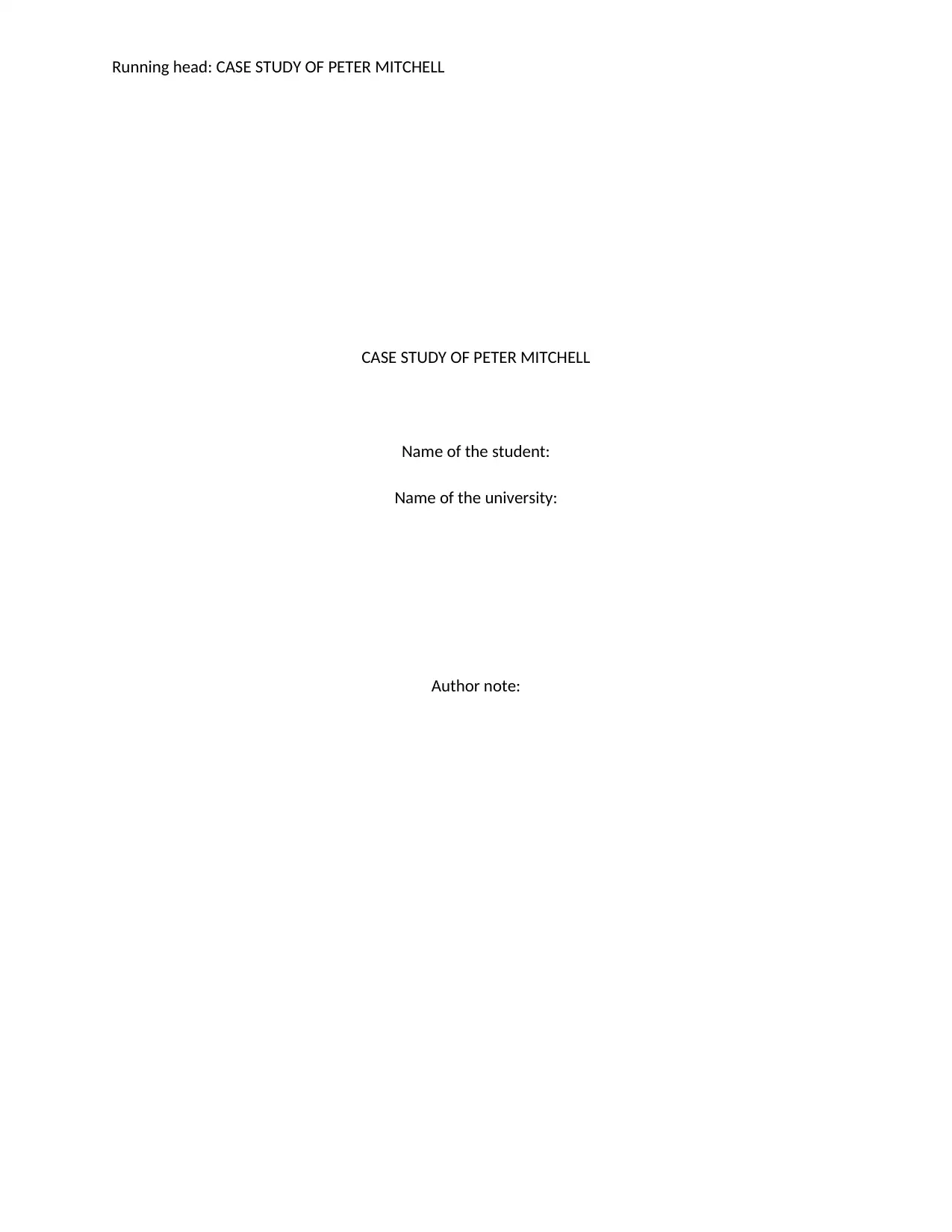
Running head: CASE STUDY OF PETER MITCHELL
CASE STUDY OF PETER MITCHELL
Name of the student:
Name of the university:
Author note:
CASE STUDY OF PETER MITCHELL
Name of the student:
Name of the university:
Author note:
Secure Best Marks with AI Grader
Need help grading? Try our AI Grader for instant feedback on your assignments.
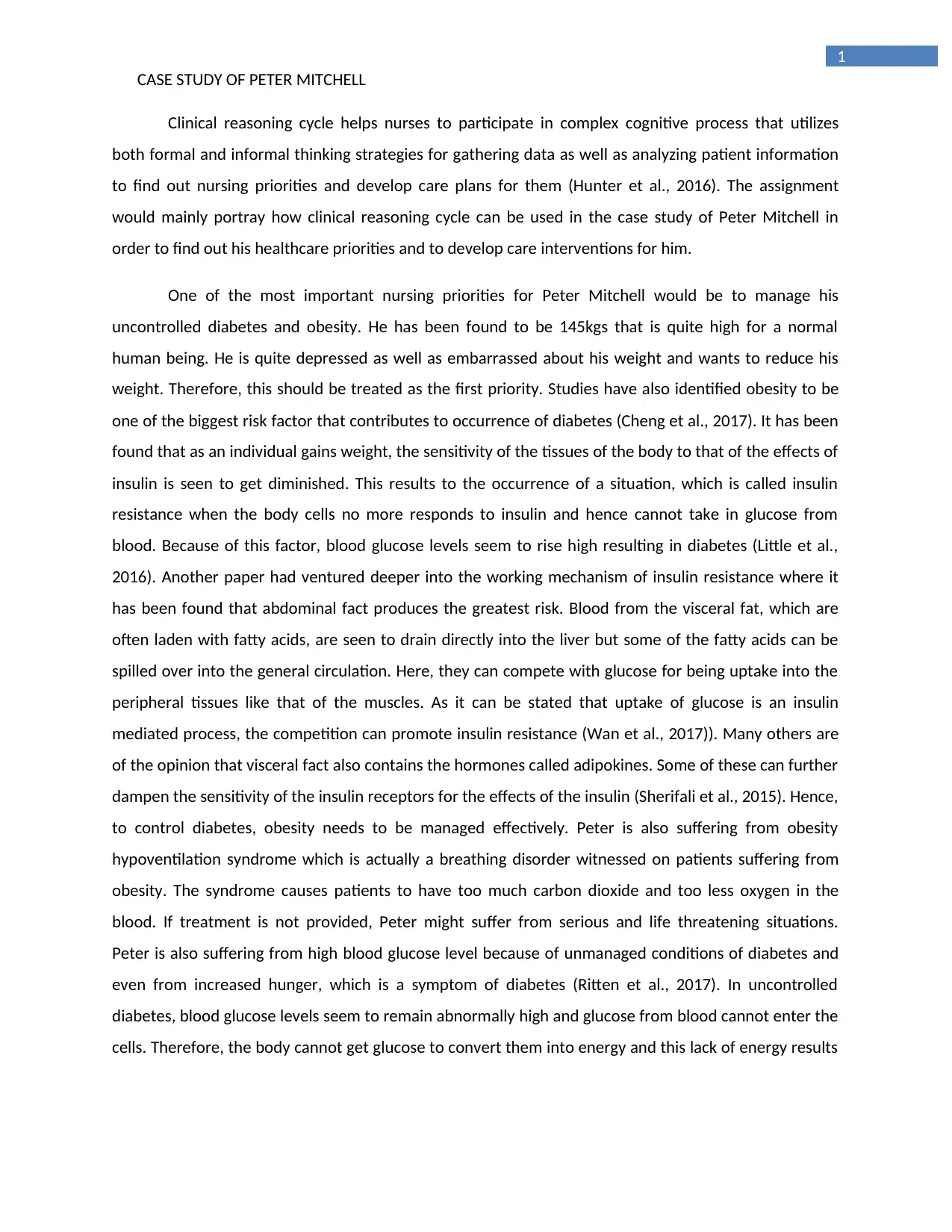
1
CASE STUDY OF PETER MITCHELL
Clinical reasoning cycle helps nurses to participate in complex cognitive process that utilizes
both formal and informal thinking strategies for gathering data as well as analyzing patient information
to find out nursing priorities and develop care plans for them (Hunter et al., 2016). The assignment
would mainly portray how clinical reasoning cycle can be used in the case study of Peter Mitchell in
order to find out his healthcare priorities and to develop care interventions for him.
One of the most important nursing priorities for Peter Mitchell would be to manage his
uncontrolled diabetes and obesity. He has been found to be 145kgs that is quite high for a normal
human being. He is quite depressed as well as embarrassed about his weight and wants to reduce his
weight. Therefore, this should be treated as the first priority. Studies have also identified obesity to be
one of the biggest risk factor that contributes to occurrence of diabetes (Cheng et al., 2017). It has been
found that as an individual gains weight, the sensitivity of the tissues of the body to that of the effects of
insulin is seen to get diminished. This results to the occurrence of a situation, which is called insulin
resistance when the body cells no more responds to insulin and hence cannot take in glucose from
blood. Because of this factor, blood glucose levels seem to rise high resulting in diabetes (Little et al.,
2016). Another paper had ventured deeper into the working mechanism of insulin resistance where it
has been found that abdominal fact produces the greatest risk. Blood from the visceral fat, which are
often laden with fatty acids, are seen to drain directly into the liver but some of the fatty acids can be
spilled over into the general circulation. Here, they can compete with glucose for being uptake into the
peripheral tissues like that of the muscles. As it can be stated that uptake of glucose is an insulin
mediated process, the competition can promote insulin resistance (Wan et al., 2017)). Many others are
of the opinion that visceral fact also contains the hormones called adipokines. Some of these can further
dampen the sensitivity of the insulin receptors for the effects of the insulin (Sherifali et al., 2015). Hence,
to control diabetes, obesity needs to be managed effectively. Peter is also suffering from obesity
hypoventilation syndrome which is actually a breathing disorder witnessed on patients suffering from
obesity. The syndrome causes patients to have too much carbon dioxide and too less oxygen in the
blood. If treatment is not provided, Peter might suffer from serious and life threatening situations.
Peter is also suffering from high blood glucose level because of unmanaged conditions of diabetes and
even from increased hunger, which is a symptom of diabetes (Ritten et al., 2017). In uncontrolled
diabetes, blood glucose levels seem to remain abnormally high and glucose from blood cannot enter the
cells. Therefore, the body cannot get glucose to convert them into energy and this lack of energy results
CASE STUDY OF PETER MITCHELL
Clinical reasoning cycle helps nurses to participate in complex cognitive process that utilizes
both formal and informal thinking strategies for gathering data as well as analyzing patient information
to find out nursing priorities and develop care plans for them (Hunter et al., 2016). The assignment
would mainly portray how clinical reasoning cycle can be used in the case study of Peter Mitchell in
order to find out his healthcare priorities and to develop care interventions for him.
One of the most important nursing priorities for Peter Mitchell would be to manage his
uncontrolled diabetes and obesity. He has been found to be 145kgs that is quite high for a normal
human being. He is quite depressed as well as embarrassed about his weight and wants to reduce his
weight. Therefore, this should be treated as the first priority. Studies have also identified obesity to be
one of the biggest risk factor that contributes to occurrence of diabetes (Cheng et al., 2017). It has been
found that as an individual gains weight, the sensitivity of the tissues of the body to that of the effects of
insulin is seen to get diminished. This results to the occurrence of a situation, which is called insulin
resistance when the body cells no more responds to insulin and hence cannot take in glucose from
blood. Because of this factor, blood glucose levels seem to rise high resulting in diabetes (Little et al.,
2016). Another paper had ventured deeper into the working mechanism of insulin resistance where it
has been found that abdominal fact produces the greatest risk. Blood from the visceral fat, which are
often laden with fatty acids, are seen to drain directly into the liver but some of the fatty acids can be
spilled over into the general circulation. Here, they can compete with glucose for being uptake into the
peripheral tissues like that of the muscles. As it can be stated that uptake of glucose is an insulin
mediated process, the competition can promote insulin resistance (Wan et al., 2017)). Many others are
of the opinion that visceral fact also contains the hormones called adipokines. Some of these can further
dampen the sensitivity of the insulin receptors for the effects of the insulin (Sherifali et al., 2015). Hence,
to control diabetes, obesity needs to be managed effectively. Peter is also suffering from obesity
hypoventilation syndrome which is actually a breathing disorder witnessed on patients suffering from
obesity. The syndrome causes patients to have too much carbon dioxide and too less oxygen in the
blood. If treatment is not provided, Peter might suffer from serious and life threatening situations.
Peter is also suffering from high blood glucose level because of unmanaged conditions of diabetes and
even from increased hunger, which is a symptom of diabetes (Ritten et al., 2017). In uncontrolled
diabetes, blood glucose levels seem to remain abnormally high and glucose from blood cannot enter the
cells. Therefore, the body cannot get glucose to convert them into energy and this lack of energy results
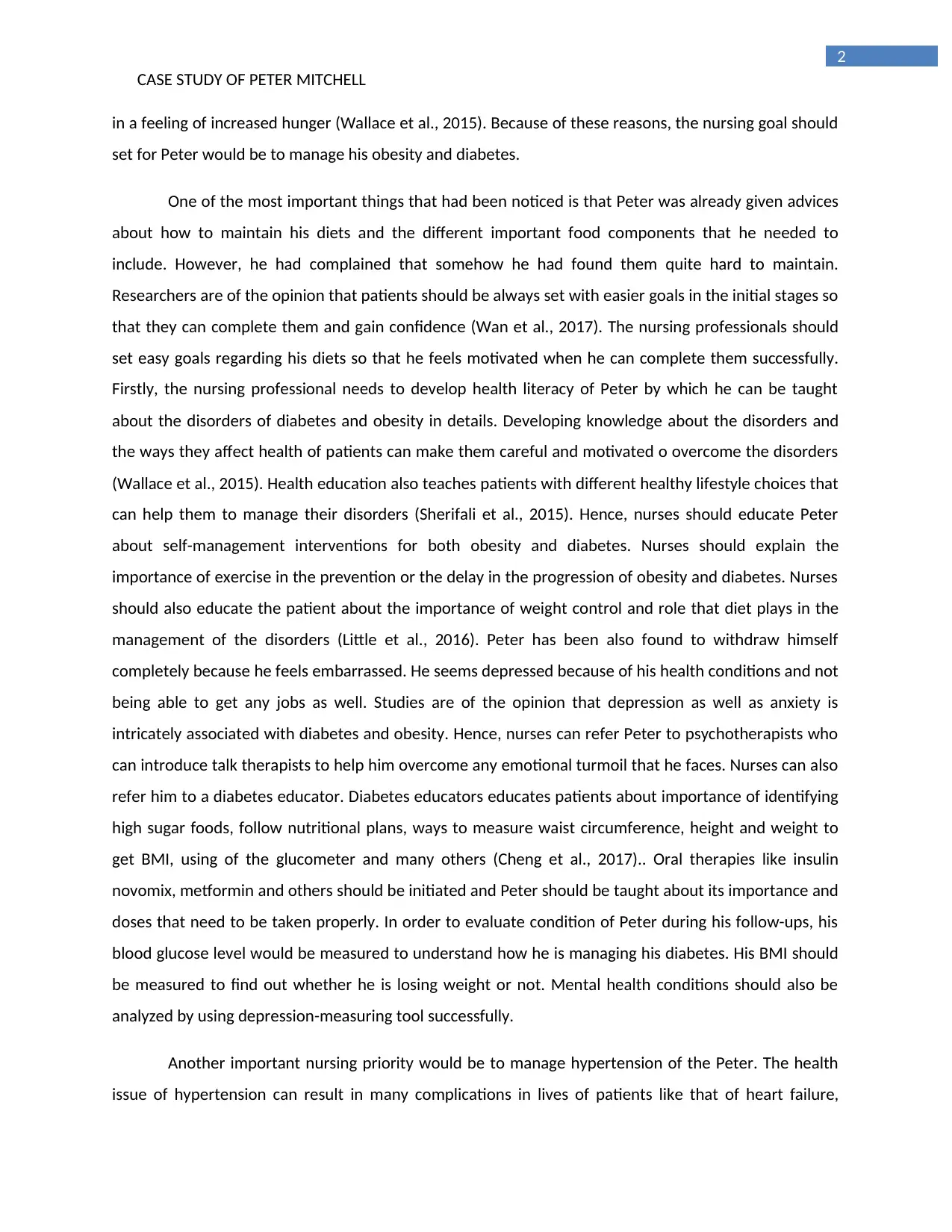
2
CASE STUDY OF PETER MITCHELL
in a feeling of increased hunger (Wallace et al., 2015). Because of these reasons, the nursing goal should
set for Peter would be to manage his obesity and diabetes.
One of the most important things that had been noticed is that Peter was already given advices
about how to maintain his diets and the different important food components that he needed to
include. However, he had complained that somehow he had found them quite hard to maintain.
Researchers are of the opinion that patients should be always set with easier goals in the initial stages so
that they can complete them and gain confidence (Wan et al., 2017). The nursing professionals should
set easy goals regarding his diets so that he feels motivated when he can complete them successfully.
Firstly, the nursing professional needs to develop health literacy of Peter by which he can be taught
about the disorders of diabetes and obesity in details. Developing knowledge about the disorders and
the ways they affect health of patients can make them careful and motivated o overcome the disorders
(Wallace et al., 2015). Health education also teaches patients with different healthy lifestyle choices that
can help them to manage their disorders (Sherifali et al., 2015). Hence, nurses should educate Peter
about self-management interventions for both obesity and diabetes. Nurses should explain the
importance of exercise in the prevention or the delay in the progression of obesity and diabetes. Nurses
should also educate the patient about the importance of weight control and role that diet plays in the
management of the disorders (Little et al., 2016). Peter has been also found to withdraw himself
completely because he feels embarrassed. He seems depressed because of his health conditions and not
being able to get any jobs as well. Studies are of the opinion that depression as well as anxiety is
intricately associated with diabetes and obesity. Hence, nurses can refer Peter to psychotherapists who
can introduce talk therapists to help him overcome any emotional turmoil that he faces. Nurses can also
refer him to a diabetes educator. Diabetes educators educates patients about importance of identifying
high sugar foods, follow nutritional plans, ways to measure waist circumference, height and weight to
get BMI, using of the glucometer and many others (Cheng et al., 2017).. Oral therapies like insulin
novomix, metformin and others should be initiated and Peter should be taught about its importance and
doses that need to be taken properly. In order to evaluate condition of Peter during his follow-ups, his
blood glucose level would be measured to understand how he is managing his diabetes. His BMI should
be measured to find out whether he is losing weight or not. Mental health conditions should also be
analyzed by using depression-measuring tool successfully.
Another important nursing priority would be to manage hypertension of the Peter. The health
issue of hypertension can result in many complications in lives of patients like that of heart failure,
CASE STUDY OF PETER MITCHELL
in a feeling of increased hunger (Wallace et al., 2015). Because of these reasons, the nursing goal should
set for Peter would be to manage his obesity and diabetes.
One of the most important things that had been noticed is that Peter was already given advices
about how to maintain his diets and the different important food components that he needed to
include. However, he had complained that somehow he had found them quite hard to maintain.
Researchers are of the opinion that patients should be always set with easier goals in the initial stages so
that they can complete them and gain confidence (Wan et al., 2017). The nursing professionals should
set easy goals regarding his diets so that he feels motivated when he can complete them successfully.
Firstly, the nursing professional needs to develop health literacy of Peter by which he can be taught
about the disorders of diabetes and obesity in details. Developing knowledge about the disorders and
the ways they affect health of patients can make them careful and motivated o overcome the disorders
(Wallace et al., 2015). Health education also teaches patients with different healthy lifestyle choices that
can help them to manage their disorders (Sherifali et al., 2015). Hence, nurses should educate Peter
about self-management interventions for both obesity and diabetes. Nurses should explain the
importance of exercise in the prevention or the delay in the progression of obesity and diabetes. Nurses
should also educate the patient about the importance of weight control and role that diet plays in the
management of the disorders (Little et al., 2016). Peter has been also found to withdraw himself
completely because he feels embarrassed. He seems depressed because of his health conditions and not
being able to get any jobs as well. Studies are of the opinion that depression as well as anxiety is
intricately associated with diabetes and obesity. Hence, nurses can refer Peter to psychotherapists who
can introduce talk therapists to help him overcome any emotional turmoil that he faces. Nurses can also
refer him to a diabetes educator. Diabetes educators educates patients about importance of identifying
high sugar foods, follow nutritional plans, ways to measure waist circumference, height and weight to
get BMI, using of the glucometer and many others (Cheng et al., 2017).. Oral therapies like insulin
novomix, metformin and others should be initiated and Peter should be taught about its importance and
doses that need to be taken properly. In order to evaluate condition of Peter during his follow-ups, his
blood glucose level would be measured to understand how he is managing his diabetes. His BMI should
be measured to find out whether he is losing weight or not. Mental health conditions should also be
analyzed by using depression-measuring tool successfully.
Another important nursing priority would be to manage hypertension of the Peter. The health
issue of hypertension can result in many complications in lives of patients like that of heart failure,
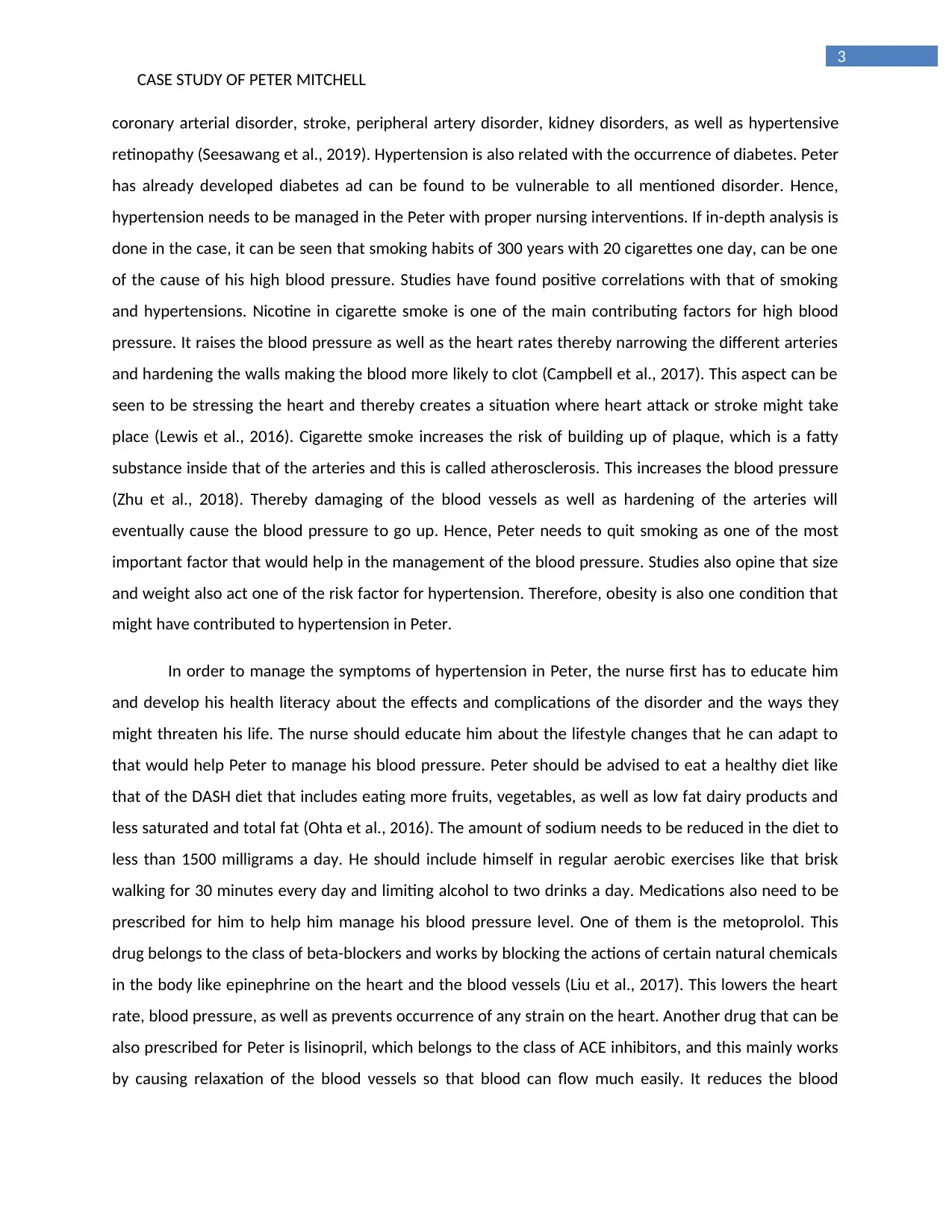
3
CASE STUDY OF PETER MITCHELL
coronary arterial disorder, stroke, peripheral artery disorder, kidney disorders, as well as hypertensive
retinopathy (Seesawang et al., 2019). Hypertension is also related with the occurrence of diabetes. Peter
has already developed diabetes ad can be found to be vulnerable to all mentioned disorder. Hence,
hypertension needs to be managed in the Peter with proper nursing interventions. If in-depth analysis is
done in the case, it can be seen that smoking habits of 300 years with 20 cigarettes one day, can be one
of the cause of his high blood pressure. Studies have found positive correlations with that of smoking
and hypertensions. Nicotine in cigarette smoke is one of the main contributing factors for high blood
pressure. It raises the blood pressure as well as the heart rates thereby narrowing the different arteries
and hardening the walls making the blood more likely to clot (Campbell et al., 2017). This aspect can be
seen to be stressing the heart and thereby creates a situation where heart attack or stroke might take
place (Lewis et al., 2016). Cigarette smoke increases the risk of building up of plaque, which is a fatty
substance inside that of the arteries and this is called atherosclerosis. This increases the blood pressure
(Zhu et al., 2018). Thereby damaging of the blood vessels as well as hardening of the arteries will
eventually cause the blood pressure to go up. Hence, Peter needs to quit smoking as one of the most
important factor that would help in the management of the blood pressure. Studies also opine that size
and weight also act one of the risk factor for hypertension. Therefore, obesity is also one condition that
might have contributed to hypertension in Peter.
In order to manage the symptoms of hypertension in Peter, the nurse first has to educate him
and develop his health literacy about the effects and complications of the disorder and the ways they
might threaten his life. The nurse should educate him about the lifestyle changes that he can adapt to
that would help Peter to manage his blood pressure. Peter should be advised to eat a healthy diet like
that of the DASH diet that includes eating more fruits, vegetables, as well as low fat dairy products and
less saturated and total fat (Ohta et al., 2016). The amount of sodium needs to be reduced in the diet to
less than 1500 milligrams a day. He should include himself in regular aerobic exercises like that brisk
walking for 30 minutes every day and limiting alcohol to two drinks a day. Medications also need to be
prescribed for him to help him manage his blood pressure level. One of them is the metoprolol. This
drug belongs to the class of beta-blockers and works by blocking the actions of certain natural chemicals
in the body like epinephrine on the heart and the blood vessels (Liu et al., 2017). This lowers the heart
rate, blood pressure, as well as prevents occurrence of any strain on the heart. Another drug that can be
also prescribed for Peter is lisinopril, which belongs to the class of ACE inhibitors, and this mainly works
by causing relaxation of the blood vessels so that blood can flow much easily. It reduces the blood
CASE STUDY OF PETER MITCHELL
coronary arterial disorder, stroke, peripheral artery disorder, kidney disorders, as well as hypertensive
retinopathy (Seesawang et al., 2019). Hypertension is also related with the occurrence of diabetes. Peter
has already developed diabetes ad can be found to be vulnerable to all mentioned disorder. Hence,
hypertension needs to be managed in the Peter with proper nursing interventions. If in-depth analysis is
done in the case, it can be seen that smoking habits of 300 years with 20 cigarettes one day, can be one
of the cause of his high blood pressure. Studies have found positive correlations with that of smoking
and hypertensions. Nicotine in cigarette smoke is one of the main contributing factors for high blood
pressure. It raises the blood pressure as well as the heart rates thereby narrowing the different arteries
and hardening the walls making the blood more likely to clot (Campbell et al., 2017). This aspect can be
seen to be stressing the heart and thereby creates a situation where heart attack or stroke might take
place (Lewis et al., 2016). Cigarette smoke increases the risk of building up of plaque, which is a fatty
substance inside that of the arteries and this is called atherosclerosis. This increases the blood pressure
(Zhu et al., 2018). Thereby damaging of the blood vessels as well as hardening of the arteries will
eventually cause the blood pressure to go up. Hence, Peter needs to quit smoking as one of the most
important factor that would help in the management of the blood pressure. Studies also opine that size
and weight also act one of the risk factor for hypertension. Therefore, obesity is also one condition that
might have contributed to hypertension in Peter.
In order to manage the symptoms of hypertension in Peter, the nurse first has to educate him
and develop his health literacy about the effects and complications of the disorder and the ways they
might threaten his life. The nurse should educate him about the lifestyle changes that he can adapt to
that would help Peter to manage his blood pressure. Peter should be advised to eat a healthy diet like
that of the DASH diet that includes eating more fruits, vegetables, as well as low fat dairy products and
less saturated and total fat (Ohta et al., 2016). The amount of sodium needs to be reduced in the diet to
less than 1500 milligrams a day. He should include himself in regular aerobic exercises like that brisk
walking for 30 minutes every day and limiting alcohol to two drinks a day. Medications also need to be
prescribed for him to help him manage his blood pressure level. One of them is the metoprolol. This
drug belongs to the class of beta-blockers and works by blocking the actions of certain natural chemicals
in the body like epinephrine on the heart and the blood vessels (Liu et al., 2017). This lowers the heart
rate, blood pressure, as well as prevents occurrence of any strain on the heart. Another drug that can be
also prescribed for Peter is lisinopril, which belongs to the class of ACE inhibitors, and this mainly works
by causing relaxation of the blood vessels so that blood can flow much easily. It reduces the blood
Secure Best Marks with AI Grader
Need help grading? Try our AI Grader for instant feedback on your assignments.
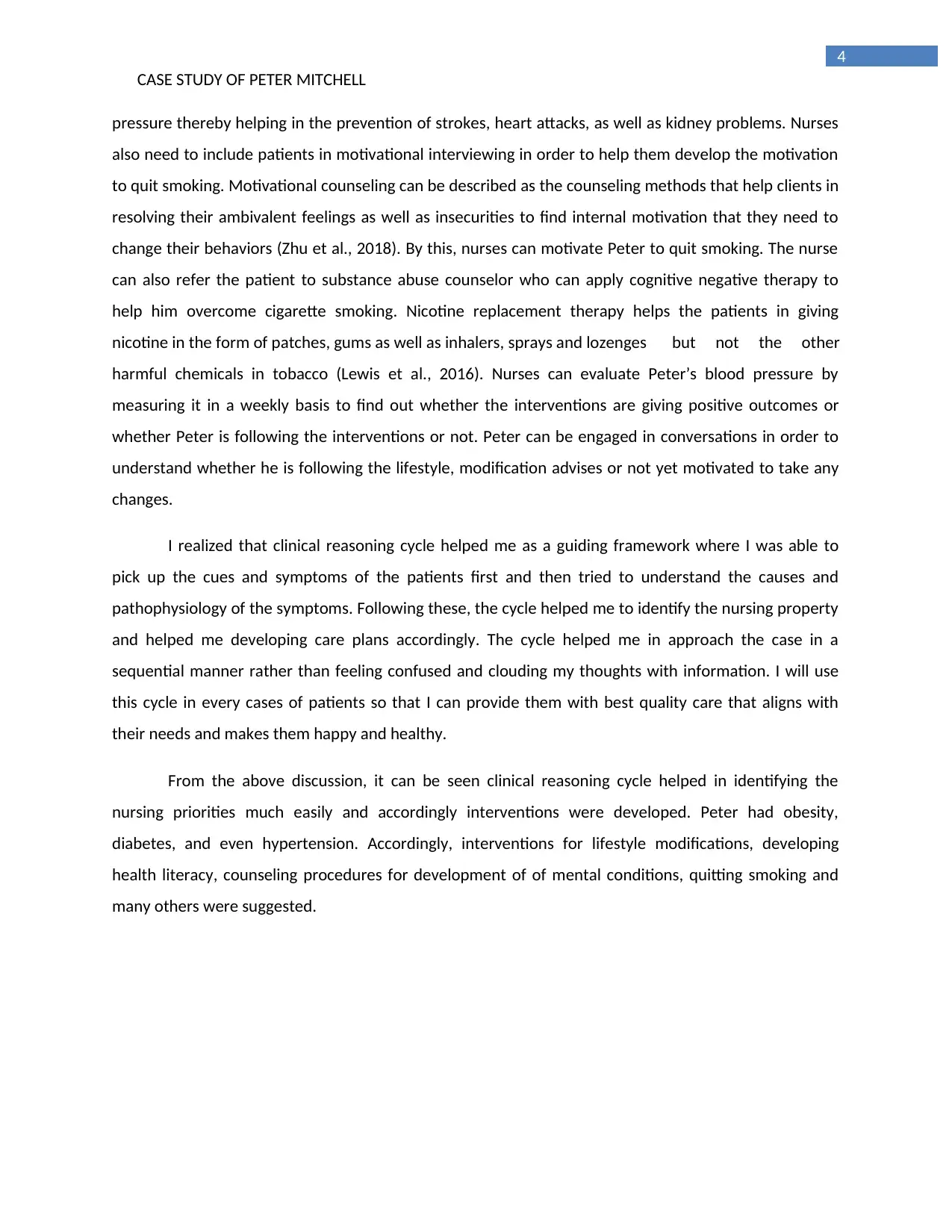
4
CASE STUDY OF PETER MITCHELL
pressure thereby helping in the prevention of strokes, heart attacks, as well as kidney problems. Nurses
also need to include patients in motivational interviewing in order to help them develop the motivation
to quit smoking. Motivational counseling can be described as the counseling methods that help clients in
resolving their ambivalent feelings as well as insecurities to find internal motivation that they need to
change their behaviors (Zhu et al., 2018). By this, nurses can motivate Peter to quit smoking. The nurse
can also refer the patient to substance abuse counselor who can apply cognitive negative therapy to
help him overcome cigarette smoking. Nicotine replacement therapy helps the patients in giving
nicotine in the form of patches, gums as well as inhalers, sprays and lozenges but not the other
harmful chemicals in tobacco (Lewis et al., 2016). Nurses can evaluate Peter’s blood pressure by
measuring it in a weekly basis to find out whether the interventions are giving positive outcomes or
whether Peter is following the interventions or not. Peter can be engaged in conversations in order to
understand whether he is following the lifestyle, modification advises or not yet motivated to take any
changes.
I realized that clinical reasoning cycle helped me as a guiding framework where I was able to
pick up the cues and symptoms of the patients first and then tried to understand the causes and
pathophysiology of the symptoms. Following these, the cycle helped me to identify the nursing property
and helped me developing care plans accordingly. The cycle helped me in approach the case in a
sequential manner rather than feeling confused and clouding my thoughts with information. I will use
this cycle in every cases of patients so that I can provide them with best quality care that aligns with
their needs and makes them happy and healthy.
From the above discussion, it can be seen clinical reasoning cycle helped in identifying the
nursing priorities much easily and accordingly interventions were developed. Peter had obesity,
diabetes, and even hypertension. Accordingly, interventions for lifestyle modifications, developing
health literacy, counseling procedures for development of of mental conditions, quitting smoking and
many others were suggested.
CASE STUDY OF PETER MITCHELL
pressure thereby helping in the prevention of strokes, heart attacks, as well as kidney problems. Nurses
also need to include patients in motivational interviewing in order to help them develop the motivation
to quit smoking. Motivational counseling can be described as the counseling methods that help clients in
resolving their ambivalent feelings as well as insecurities to find internal motivation that they need to
change their behaviors (Zhu et al., 2018). By this, nurses can motivate Peter to quit smoking. The nurse
can also refer the patient to substance abuse counselor who can apply cognitive negative therapy to
help him overcome cigarette smoking. Nicotine replacement therapy helps the patients in giving
nicotine in the form of patches, gums as well as inhalers, sprays and lozenges but not the other
harmful chemicals in tobacco (Lewis et al., 2016). Nurses can evaluate Peter’s blood pressure by
measuring it in a weekly basis to find out whether the interventions are giving positive outcomes or
whether Peter is following the interventions or not. Peter can be engaged in conversations in order to
understand whether he is following the lifestyle, modification advises or not yet motivated to take any
changes.
I realized that clinical reasoning cycle helped me as a guiding framework where I was able to
pick up the cues and symptoms of the patients first and then tried to understand the causes and
pathophysiology of the symptoms. Following these, the cycle helped me to identify the nursing property
and helped me developing care plans accordingly. The cycle helped me in approach the case in a
sequential manner rather than feeling confused and clouding my thoughts with information. I will use
this cycle in every cases of patients so that I can provide them with best quality care that aligns with
their needs and makes them happy and healthy.
From the above discussion, it can be seen clinical reasoning cycle helped in identifying the
nursing priorities much easily and accordingly interventions were developed. Peter had obesity,
diabetes, and even hypertension. Accordingly, interventions for lifestyle modifications, developing
health literacy, counseling procedures for development of of mental conditions, quitting smoking and
many others were suggested.
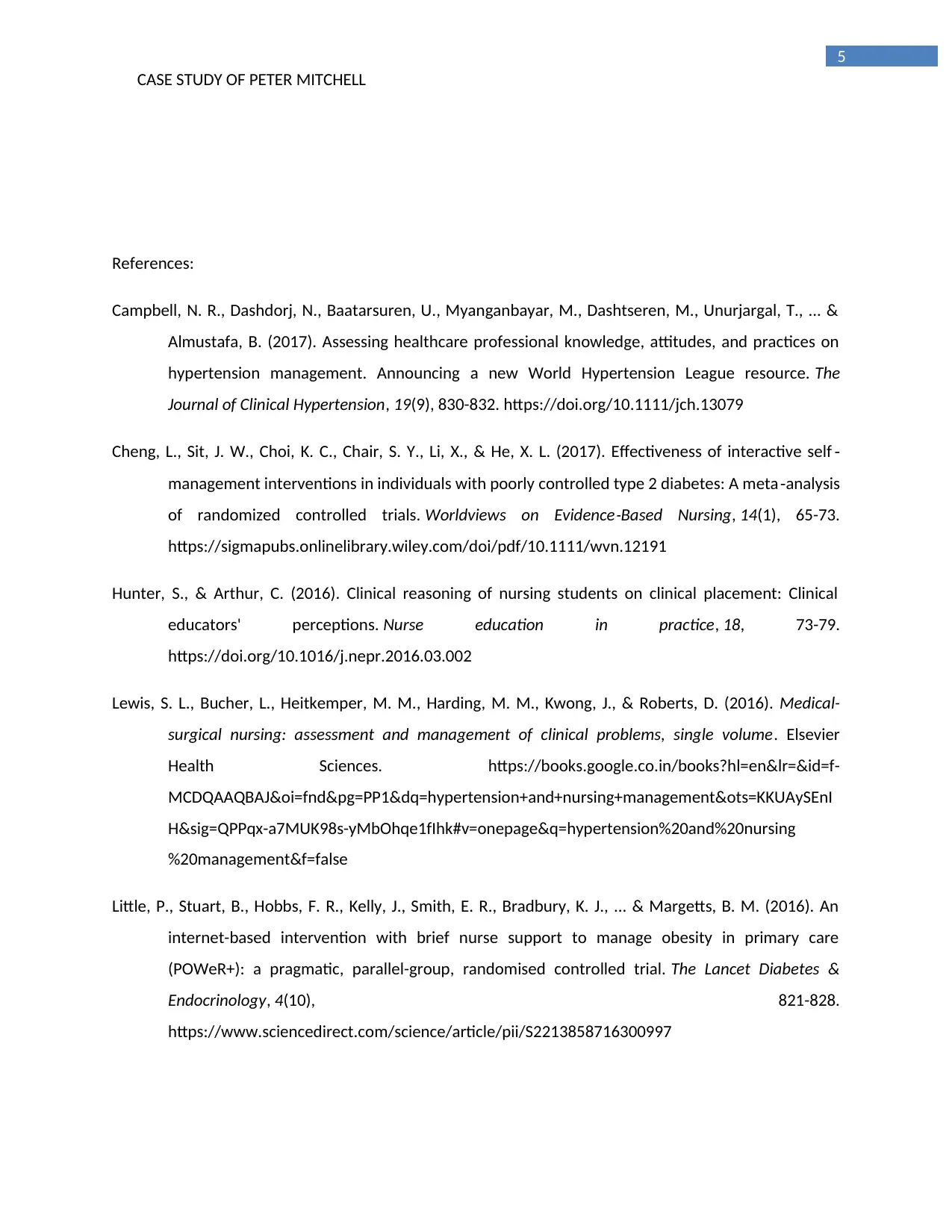
5
CASE STUDY OF PETER MITCHELL
References:
Campbell, N. R., Dashdorj, N., Baatarsuren, U., Myanganbayar, M., Dashtseren, M., Unurjargal, T., ... &
Almustafa, B. (2017). Assessing healthcare professional knowledge, attitudes, and practices on
hypertension management. Announcing a new World Hypertension League resource. The
Journal of Clinical Hypertension, 19(9), 830-832. https://doi.org/10.1111/jch.13079
Cheng, L., Sit, J. W., Choi, K. C., Chair, S. Y., Li, X., & He, X. L. (2017). Effectiveness of interactive self ‐
management interventions in individuals with poorly controlled type 2 diabetes: A meta‐analysis
of randomized controlled trials. Worldviews on Evidence
‐Based Nursing, 14(1), 65-73.
https://sigmapubs.onlinelibrary.wiley.com/doi/pdf/10.1111/wvn.12191
Hunter, S., & Arthur, C. (2016). Clinical reasoning of nursing students on clinical placement: Clinical
educators' perceptions. Nurse education in practice, 18, 73-79.
https://doi.org/10.1016/j.nepr.2016.03.002
Lewis, S. L., Bucher, L., Heitkemper, M. M., Harding, M. M., Kwong, J., & Roberts, D. (2016). Medical-
surgical nursing: assessment and management of clinical problems, single volume. Elsevier
Health Sciences. https://books.google.co.in/books?hl=en&lr=&id=f-
MCDQAAQBAJ&oi=fnd&pg=PP1&dq=hypertension+and+nursing+management&ots=KKUAySEnI
H&sig=QPPqx-a7MUK98s-yMbOhqe1fIhk#v=onepage&q=hypertension%20and%20nursing
%20management&f=false
Little, P., Stuart, B., Hobbs, F. R., Kelly, J., Smith, E. R., Bradbury, K. J., ... & Margetts, B. M. (2016). An
internet-based intervention with brief nurse support to manage obesity in primary care
(POWeR+): a pragmatic, parallel-group, randomised controlled trial. The Lancet Diabetes &
Endocrinology, 4(10), 821-828.
https://www.sciencedirect.com/science/article/pii/S2213858716300997
CASE STUDY OF PETER MITCHELL
References:
Campbell, N. R., Dashdorj, N., Baatarsuren, U., Myanganbayar, M., Dashtseren, M., Unurjargal, T., ... &
Almustafa, B. (2017). Assessing healthcare professional knowledge, attitudes, and practices on
hypertension management. Announcing a new World Hypertension League resource. The
Journal of Clinical Hypertension, 19(9), 830-832. https://doi.org/10.1111/jch.13079
Cheng, L., Sit, J. W., Choi, K. C., Chair, S. Y., Li, X., & He, X. L. (2017). Effectiveness of interactive self ‐
management interventions in individuals with poorly controlled type 2 diabetes: A meta‐analysis
of randomized controlled trials. Worldviews on Evidence
‐Based Nursing, 14(1), 65-73.
https://sigmapubs.onlinelibrary.wiley.com/doi/pdf/10.1111/wvn.12191
Hunter, S., & Arthur, C. (2016). Clinical reasoning of nursing students on clinical placement: Clinical
educators' perceptions. Nurse education in practice, 18, 73-79.
https://doi.org/10.1016/j.nepr.2016.03.002
Lewis, S. L., Bucher, L., Heitkemper, M. M., Harding, M. M., Kwong, J., & Roberts, D. (2016). Medical-
surgical nursing: assessment and management of clinical problems, single volume. Elsevier
Health Sciences. https://books.google.co.in/books?hl=en&lr=&id=f-
MCDQAAQBAJ&oi=fnd&pg=PP1&dq=hypertension+and+nursing+management&ots=KKUAySEnI
H&sig=QPPqx-a7MUK98s-yMbOhqe1fIhk#v=onepage&q=hypertension%20and%20nursing
%20management&f=false
Little, P., Stuart, B., Hobbs, F. R., Kelly, J., Smith, E. R., Bradbury, K. J., ... & Margetts, B. M. (2016). An
internet-based intervention with brief nurse support to manage obesity in primary care
(POWeR+): a pragmatic, parallel-group, randomised controlled trial. The Lancet Diabetes &
Endocrinology, 4(10), 821-828.
https://www.sciencedirect.com/science/article/pii/S2213858716300997
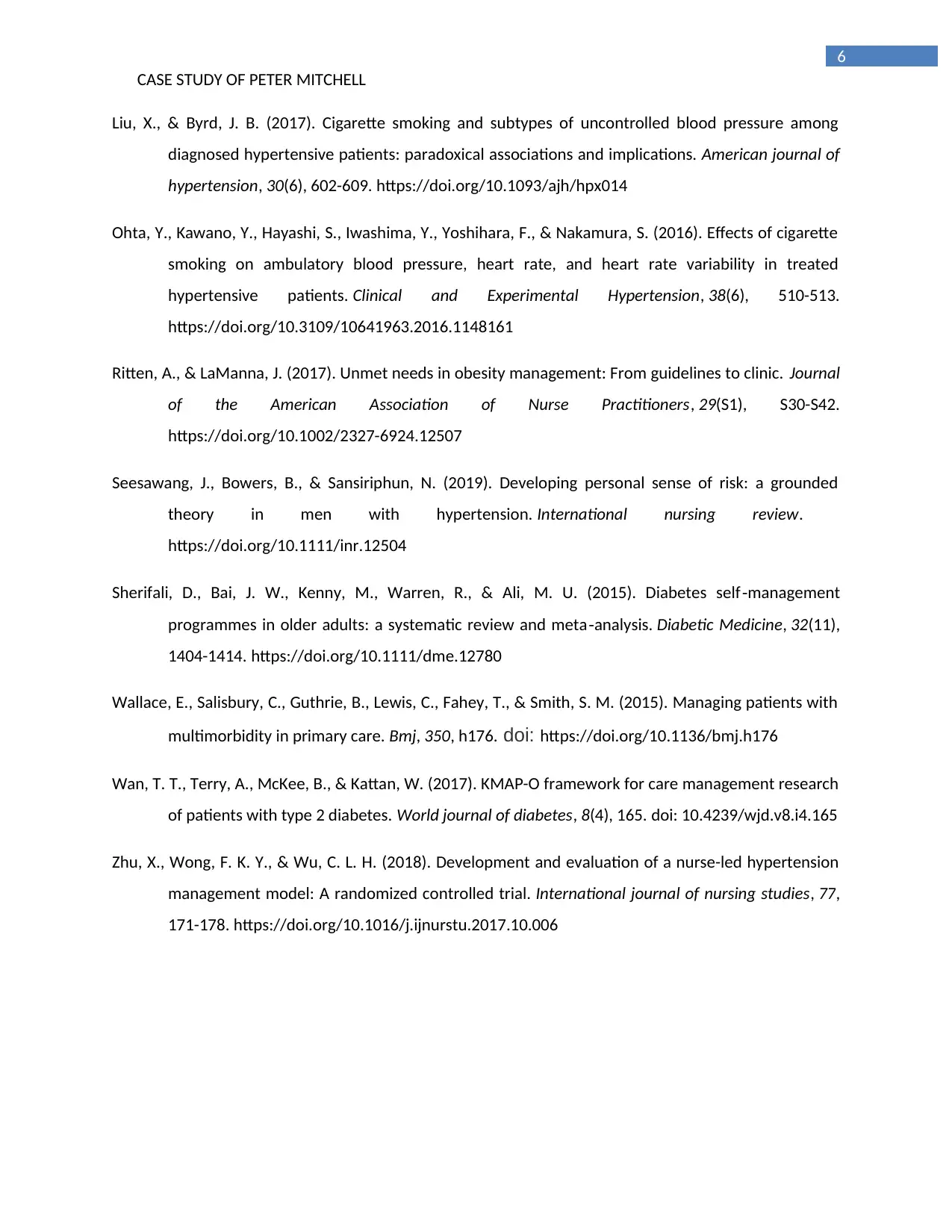
6
CASE STUDY OF PETER MITCHELL
Liu, X., & Byrd, J. B. (2017). Cigarette smoking and subtypes of uncontrolled blood pressure among
diagnosed hypertensive patients: paradoxical associations and implications. American journal of
hypertension, 30(6), 602-609. https://doi.org/10.1093/ajh/hpx014
Ohta, Y., Kawano, Y., Hayashi, S., Iwashima, Y., Yoshihara, F., & Nakamura, S. (2016). Effects of cigarette
smoking on ambulatory blood pressure, heart rate, and heart rate variability in treated
hypertensive patients. Clinical and Experimental Hypertension, 38(6), 510-513.
https://doi.org/10.3109/10641963.2016.1148161
Ritten, A., & LaManna, J. (2017). Unmet needs in obesity management: From guidelines to clinic. Journal
of the American Association of Nurse Practitioners, 29(S1), S30-S42.
https://doi.org/10.1002/2327-6924.12507
Seesawang, J., Bowers, B., & Sansiriphun, N. (2019). Developing personal sense of risk: a grounded
theory in men with hypertension. International nursing review.
https://doi.org/10.1111/inr.12504
Sherifali, D., Bai, J. W., Kenny, M., Warren, R., & Ali, M. U. (2015). Diabetes self‐management
programmes in older adults: a systematic review and meta‐analysis. Diabetic Medicine, 32(11),
1404-1414. https://doi.org/10.1111/dme.12780
Wallace, E., Salisbury, C., Guthrie, B., Lewis, C., Fahey, T., & Smith, S. M. (2015). Managing patients with
multimorbidity in primary care. Bmj, 350, h176. doi: https://doi.org/10.1136/bmj.h176
Wan, T. T., Terry, A., McKee, B., & Kattan, W. (2017). KMAP-O framework for care management research
of patients with type 2 diabetes. World journal of diabetes, 8(4), 165. doi: 10.4239/wjd.v8.i4.165
Zhu, X., Wong, F. K. Y., & Wu, C. L. H. (2018). Development and evaluation of a nurse-led hypertension
management model: A randomized controlled trial. International journal of nursing studies, 77,
171-178. https://doi.org/10.1016/j.ijnurstu.2017.10.006
CASE STUDY OF PETER MITCHELL
Liu, X., & Byrd, J. B. (2017). Cigarette smoking and subtypes of uncontrolled blood pressure among
diagnosed hypertensive patients: paradoxical associations and implications. American journal of
hypertension, 30(6), 602-609. https://doi.org/10.1093/ajh/hpx014
Ohta, Y., Kawano, Y., Hayashi, S., Iwashima, Y., Yoshihara, F., & Nakamura, S. (2016). Effects of cigarette
smoking on ambulatory blood pressure, heart rate, and heart rate variability in treated
hypertensive patients. Clinical and Experimental Hypertension, 38(6), 510-513.
https://doi.org/10.3109/10641963.2016.1148161
Ritten, A., & LaManna, J. (2017). Unmet needs in obesity management: From guidelines to clinic. Journal
of the American Association of Nurse Practitioners, 29(S1), S30-S42.
https://doi.org/10.1002/2327-6924.12507
Seesawang, J., Bowers, B., & Sansiriphun, N. (2019). Developing personal sense of risk: a grounded
theory in men with hypertension. International nursing review.
https://doi.org/10.1111/inr.12504
Sherifali, D., Bai, J. W., Kenny, M., Warren, R., & Ali, M. U. (2015). Diabetes self‐management
programmes in older adults: a systematic review and meta‐analysis. Diabetic Medicine, 32(11),
1404-1414. https://doi.org/10.1111/dme.12780
Wallace, E., Salisbury, C., Guthrie, B., Lewis, C., Fahey, T., & Smith, S. M. (2015). Managing patients with
multimorbidity in primary care. Bmj, 350, h176. doi: https://doi.org/10.1136/bmj.h176
Wan, T. T., Terry, A., McKee, B., & Kattan, W. (2017). KMAP-O framework for care management research
of patients with type 2 diabetes. World journal of diabetes, 8(4), 165. doi: 10.4239/wjd.v8.i4.165
Zhu, X., Wong, F. K. Y., & Wu, C. L. H. (2018). Development and evaluation of a nurse-led hypertension
management model: A randomized controlled trial. International journal of nursing studies, 77,
171-178. https://doi.org/10.1016/j.ijnurstu.2017.10.006
1 out of 7
Related Documents
Your All-in-One AI-Powered Toolkit for Academic Success.
+13062052269
info@desklib.com
Available 24*7 on WhatsApp / Email
![[object Object]](/_next/static/media/star-bottom.7253800d.svg)
Unlock your academic potential
© 2024 | Zucol Services PVT LTD | All rights reserved.





